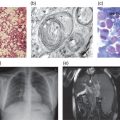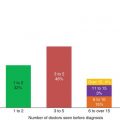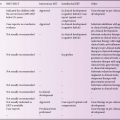- Gaucher disease types 1 and 3 (imiglucerase, velaglucerase alfa, taliglucerase alfa)*
- Anderson-Fabry disease (agalsidase alfa and agalsidase beta)
- Mucopolysaccharidosis type I (laronidase)
- Mucopolysaccharidosis type II (idursulfase)
- Mucopolysaccharidosis VI (galsulfase)
- Glycogenosis type ll A/Pompe (alglucosidase alfa)
Diseases for which enzyme therapy is in clinical development
- Niemann-Pick disease B
- Sanfilippo A and B (MPS 3A & 3B)
- Morquio A and B (MPS 4A & 4B)
- Metachromatic leukodystrophy
- Alpha mannosidosis
*only imiglucerase licensed for use specifically in type 3 Gaucher disease
Velaglucerase (VPRIV™, Shire Human Genetic Therapies) a recombinant human β-glucocerebrosidase expressed after activating the endogenous GBA1 gene in human fibrosarcoma cells cultured in the presence of an inhibitor of glycoprotein processing (kifunensine) to yield a highly mannosylated product was approved in 2010 for marketing in the USA and Europe. In May 2012, a mannose-terminated preparation of human β-glucocerebrosidase (taliglucerase-alfa; Elelyso) manufactured in genetically engineered carrot cells has been approved by the US Food and Drug Administration for the treatment of adult patients with type 1 Gaucher disease. Elelyso is manufactured and distributed by Pfizer Inc., under license from Protalix BioTherapeutics Inc (Carmiel-Israel). The most common side effects reported during clinical studies were infusion reactions and allergic reactions.
Generally the infusion-related reactions are mild and, in treatment-naïve patients, occurred mostly during the first months of treatment; they tend to occur less frequently with time. Therapeutic goals in Gaucher disease, as well as guidelines for monitoring, were published by an expert panel in 2004; these guidelines are used to generate an individualized plan of treatment to optimize the management of the disease. While often useful in practice, these therapeutic goals may not be sensitive to all health changes during monitoring and should not be regarded as fixed points of care for a given patient.
Fabry disease
Fabry disease (see Chapter 7) has been treated with α-galactosidase A since 2001 and two competing enzyme preparations – agalsidase alfa (Replagal™) and agalsidase beta (Fabrazyme™) – are authorized for use in Europe whereas in the United States, at the time of writing, only agalsidase beta is authorized. Enzyme therapy showed efficacy in clinical trials, principally in male hemizygous patients at an early phase of disease; treatment has effects on myocardial hypertrophy, renal impairment, pain, and quality of life. However, no conclusion can be drawn from direct comparison of the therapeutic responses between the two available enzyme preparations – even though the licensed dose of agalsidase alfa (0.2 mg/kg/month) is materially less than agalsidase beta (1.0 mg/kg/month). Male patients with Fabry disease frequently develop antibodies associated with infusion reactions; while there may be a greater antigenic response to agalsidase beta, cross-reactivity between the two preparations is often found.
Mucopolysaccharidoses (see Chapter 12)
MPS I (Hurler–Scheie disease)
Enzyme therapy with laronidase (Aldurazyme™), licensed for treatment of the systemic manifestations of MPS I, improves liver size, linear growth, joint mobility, breathing, and sleep apnea in persons with the attenuated form of disease. The timing at which enzyme therapy is started is likely to influence the outcome.
MPS II (Hunter disease)
After early development by Transkaryotic Therapies Inc., to augment the impaired capacity of tissues in Hunter patients to digest sulfated glycosaminoglycans, including heparan sulfate, the enzyme preparation, idursulfase (Elaprase™), has been marketed for MPS II by Shire Human Genetic Therapies. Idursulfase contains eight asparagine-linked glycosylation sites occupied by complex oligosaccharide chains decorated by mannose-6-phosphate residues to allow specific binding of the enzyme to the cognate receptors on the cell surface and subsequent cellular internalization of the enzyme and delivery to lysosomes. As with other sulphatases, the enzyme activity of idursulfase is dependent on the posttranslational modification of an active-site cysteine to formylglycine. Elaprase™ is approved in the United States and the European Union and marketed in many countries. Idursulfase has principally been studied in individuals with the attenuated form of Hunter disease and limited information is available on the outcome of enzyme therapy in young children (< 5 years) or individuals with respiratory difficulties or severe neurological disease. Since proteins do not materially traverse the blood–brain barrier, enzyme treatment would not be expected to improve the cognitive and related features of disease affecting the brain.
MPS IV A (Morquio disease)
Enzyme treatment of Morquio A syndrome (MPS IVA) using N-acetylgalactosamine-6 sulphatase (Biomarin Pharmaceuticals) is expected to clear keratan sulphate from the lysosomal compartment and arrest progression of the disease; it may ameliorate other manifestations. The enzyme preparation harbours mannose-6-phosphate residues on the glycan chains, thus allowing cellular uptake by the mannose-6-phosphate receptor and delivery to the lysosomes. A randomized, placebo-controlled double-blind phase 3 study is currently under way to evaluate the efficacy and safety of 2.0 mg/kg/week and 2.0 mg/kg/alternate weeks. The primary outcome will be based on the 6-minute Walk test and with secondary outcome measures change from baseline in endurance as measured by the 3-minute Stair-Climb test as well as changes from baseline in urine keratan sulfate excretion.
MPS VI (Maroteaux–Lamy disease)
Galsulfase (Naglazyme™), which has been developed by the Biomarin Pharmaceutical company, is a recombinant version of N-acetylgalactosamine 4-sulphatase(arylsulphatase B), and was licensed in 2005/6 in the United States and Europe (and latterly in many other countries); the agent has been shown to improve walking and stair-climbing capacity in patients with MPS VI [ 3 ].
Pompe disease (acid maltase deficiency; glycogen storage disease type 2 – see Chapter 13)
The doses of recombinant human acid α-glucosidase displaying mannose-6-phosphate residues used to treat Pompe disease exceed by an order of magnitude those used in other lysosomal disorders (20–40 mg/kg, compared with 0.1–2 mg/kg). This, combined with the absence of endogenous acid α-glucosidase cross-reacting antigen (CRIM-ve) in many infants with the condition contributes to the development of important immune reactions which frequently complicate therapy. It is becoming clear that infants showing little or no clinical response to the treatment lack expression of endogenous acid α-glucosidase antigen (CRIM-ve). They generate high-titre IgG antibodies which may inhibit the enzyme in vitro. Those who develop IgE antibodies to alglucosidase alfa are at a high risk of severe allergic reactions and even anaphylaxis; close monitoring of enzyme infusions is mandatory. These and others who are severely compromised may require radical immunomodulatory intervention – including the use of rituximab or omalizumab – in attempts to overcome the barrier to life-saving treatment [12]. As described in Chapter 13, however, Myozyme™ prolongs life when administered to very young infants with Pompe disease who do not develop high-titre antibodies, and in a controlled clinical trial shows clear benefit when given to adults, preventing respiratory failure and with improvement in skeletal muscle function [13]. The long-term health outcome in severely affected infants after life-saving treatment has yet to be reported.
Alpha-mannosidosis (see Chapter 14)
After the cloning and expression of human α-mannosidase and several years of promising preclinical animal studies into the use of enzyme therapy for human α-mannosidosis, phase 1/2 clinical trials have been announced and recruitment is now closed for a single centre, randomized open-label, multiple-dose study of the efficacy and long-term safety of recombinant human alpha-mannosidase (Lamazym™). The manufacturer of this enzyme preparation is the Zymenex company and the results of this clinical trial in such a severely disabling and rare disorder are awaited eagerly.
Niemann–Pick disease type B (see Chapter 10)
The Genzyme Corporation has two approved clinical research studies for individuals with Niemann–Pick disease caused by acid sphingomyelinase deficiency (types A and B). Clinical studies are long-awaited and significant delays in the testing of the recombinant human enzyme are in part the result of dose-related toxicity in preclinical studies using genetically modified mice. The author considers it possible that increased intracellular concentrations of ceramide, a recognized cell-death signal released directly from sphingomyelin by the action of acid sphingomyelinase, may have caused toxicity and thus contributed to entirely appropriate delays in the clinical development of enzyme therapy by Drs Schuchmann and Desnick at Mount Sinai hospital in New York.
Substrate restriction therapy (“substrate reduction therapy”)
Mode of action
This stratagem seeks to compensate for the impaired ability of a lysosomal enzyme to break down its physiological target molecules. The use of an inhibitor to decrease the rate of formation of the specific material, the breakdown of which is defective in a given disorder, depends upon identifying very selective compounds which modulate substrate formation at early steps in their production, thus allowing the residual activity of the degradative enzyme system to cope with new incoming material for digestion. Inhibitors that influence sphingolipid biosynthesis have received considerable attention for pharmaceutical development; if suitable compounds can be found for other molecular pathways, the approach could be applied more generally.
Sphingolipidoses: general considerations
The inhibitory action is directed to UDP-glucose: N-acylsphingosine glucosyltransferase, the first committed step for the biosynthesis of β-glucosylceramide and its derivatives. β-Glucosylceramide is the precursor of several hundred glycolipid products of combinatorial reactions catalyzed by the addition of simple sugar moieties. According to the nature of the inherited biochemical defect in lysosomal breakdown and recycling, members of this complex sphingolipid family accumulate in Gaucher disease, Fabry disease, and the GM1 and GM2 gangliosidoses. Inhibition of UDP-glucose: N-acylsphingosine glucosyltransferase (UDP-glucosylceramide transferase) was predicted by Norman Radin to serve as the immediate target of therapy in Gaucher disease.
The sugar mimetic, miglustat (N-butyldeoxynojirimycin), is approved for the treatment of Gaucher disease and Niemann–Pick C disease (the latter in the EU). This iminosugar inhibits glycosidases, including α-glycosidases and at micromolar concentrations inhibits N-acylsphingosine glucosyltransferase, and consequently the biosynthesis of β-glucosylceramide (glucocerebroside) in cultured cells. It is likely that the action of miglustat arises from its monosaccharide structure and that it serves as an inhibitory mimic of the sugar nucleotide substrate.
Eliglustat tartrate (Genz-112638) is in late clinical development by the Genzyme Corporation for the treatment of Gaucher disease – with possible application to cognate glycosphingolipidoses. It is also a potent, specific and orally active inhibitor (Ki ~25 nM) of its molecular target, N-acylsphingosine glucosyltransferase).
Application to specific diseases
Gaucher disease
Miglustat
After encouraging preclinical studies, a clinical trial of miglustat (Zavesca®) in patients with mild-to-moderate type I Gaucher disease, using 100 mg thrice daily, showed that the agent reduced visceral enlargement and improved haematological parameters, as well as the plasma biomarker of storage macrophages, chitotriosidase.
As a small iminosugar molecule that penetrates the blood–brain barrier, miglustat was explored in children with chronic neuronopathic (type 3) Gaucher disease. Unfortunately, this trial failed to meet its clinical end points and the drug is not recommended for neurological manifestations in Gaucher disease.
Eliglustat tartrate
In healthy volunteers, plasma glucocerebroside concentrations were diminished after oral dosing with eliglustat tartrate, and in open-label phase II clinical trials in patients with type 1 (non-neuronopathic) Gaucher disease, spleen and liver volumes were decreased together with impressive haematological responses.
Stay updated, free articles. Join our Telegram channel

Full access? Get Clinical Tree








